Publications
Peer-Reviewed Articles
Anna Toldrà, Alar Ainla, Shirin Khaliliazar, Roman Landin, Georgios Chondrogiannis, Martin Hanze, Pedro Réu, Mahiar M. Hamedi Analyst 2022, 147, 4249-4256.
LINK TO ARTICLE
The realization of electrochemical nucleic acid amplification tests (NAATs) at the point of care (POC) is highly desirable, but it remains a challenge given their high cost and lack of true portability/miniaturization. Here we show that mass-produced, industrial standardized, printed circuit boards (PCBs) can be repurposed to act as near-zero cost electrodes for self-assembled monolayer-based DNA biosensing, and further integration with a custom-designed and low-cost portable potentiostat. To show the analytical capability of this system, we developed a NAAT using isothermal recombinase polymerase amplification, bypassing the need of thermal cyclers, followed by an electrochemical readout relying on a sandwich hybridization assay. We used our sensor and device for analytical detection of the toxic microalgae Ostreopsis cf. ovata as a proof of concept. This work shows the potential of PCBs and open-source electronics to be used as powerful POC DNA biosensors at a low-cost.

Karolina Spustova, Elif Senem Köksal, Alar Ainla, Irep Gözen Small 2020, 2005320
LINK TO ARTICLE
Membrane enclosed intracellular compartments have been exclusively associated with the eukaryotes, represented by the highly compartmentalized last eukaryotic common ancestor. Recent evidence showing the presence of membranous compartments with specific functions in archaea and bacteria makes it conceivable that the last universal common ancestor and its hypothetical precursor, the protocell, may have exhibited compartmentalization. To the authors' knowledge, there are no experimental studies yet that have tested this hypothesis. They report on an autonomous subcompartmentalization mechanism for protocells which results in the transformation of initial subcompartments to daughter protocells. The process is solely determined by the fundamental materials properties and interfacial events, and does not require biological machinery or chemical energy supply. In the light of the authors' findings, it is proposed that similar events may have taken place under early Earth conditions, leading to the development of compartmentalized cells and potentially, primitive division.
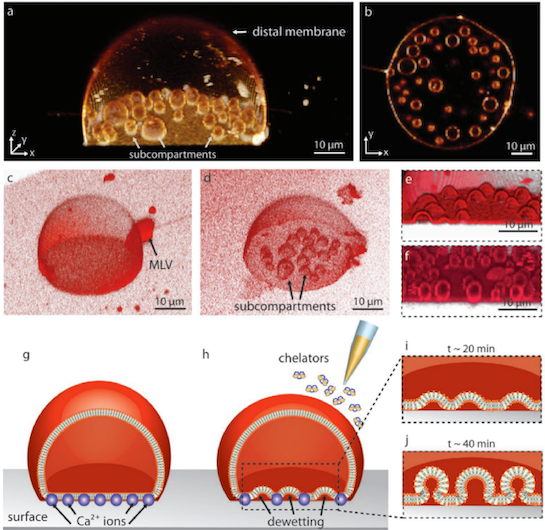
Silver Jõemetsa, Karolina Spustova, Kiryl Kustanovich, Alar Ainla, Severin Schindler, Siegfried Eigler, Tatsiana Lobovkina, Samuel Lara-Avila, Aldo Jesorka, Irep Gözen Langmuir 2019, 35(32), 10286-10298.
LINK TO ARTICLE
In this study, we have systematically investigated the formation of molecular phospholipid films on a variety of solid substrates fabricated from typical surface engineering materials and the fluidic properties of the lipid membranes formed on these substrates. The surface materials comprise of borosilicate glass, mica, SiO2, Al (native oxide), Al2O3, TiO2, ITO, SiC, Au, Teflon AF, SU-8, and graphene. We deposited the lipid films from small unilamellar vesicles (SUVs) by means of an open-space microfluidic device, observed the formation and development of the films by laser scanning confocal microscopy, and evaluated the mode and degree of coverage, fluidity, and integrity. In addition to previously established mechanisms of lipid membrane–surface interaction upon bulk addition of SUVs on solid supports, we observed nontrivial lipid adhesion phenomena, including reverse rolling of spreading bilayers, spontaneous nucleation and growth of multilamellar vesicles, and the formation of intact circular patches of double lipid bilayer membranes. Our findings allow for accurate prediction of membrane-surface interactions in microfabricated devices and experimental environments where model membranes are used as functional biomimetic coatings.
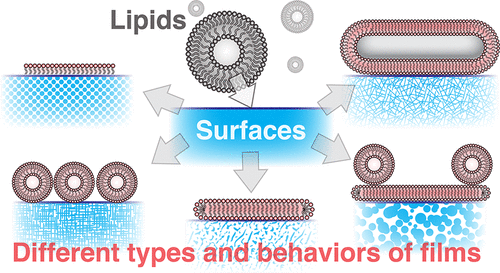
Brian J Cafferty, Victoria E Campbell, Philipp Rothemund, Daniel J Preston, Alar Ainla, Nicolas Fulleringer, Alina C Diaz, Alberto E Fuentes, Dan Sameoto, Jennifer A Lewis, George M Whitesides Advanced Materials Technologies, 2019, 4(1), 1800299.
LINK TO ARTICLE
This paper describes the fabrication of elastomeric three/dimensional (3D) structures starting from two-dimensional (2D) sheets using a combination of direct-ink printing and relaxation of strain. These structures are fabricated in a two-step process: first, elastomeric inks are deposited as 2D structures on a stretched elastomeric sheet, and second, after curing of the elastomeric inks, relaxation of strain in the 2D sheet causes it to deform into a 3D shape. To predict bending of elastomeric objects fabricated with this technique, a simple mechanical model is developed. The strategy of using initially 2D materials to fabricate 3D structures offers four new features that complement digital fabrication techniques. (i) It provides a simple route to create shapes with complex curves, suspended features, and internal cavities. (ii) It is a faster method of fabricating some types of shapes than "conventional" 3D printing, because the features are printed in 2D. (iii) It forms surfaces that can be both smoother, and structured in a way that is not compatible with layer-by-layer processing. (iv) It forms structures that can be deformed reversibly after fabrication by reapplying strain. This paper demonstrates these features by fabrication of helices, structures inspired by cubes and tables, "pop-up" structures, and soft grippers.
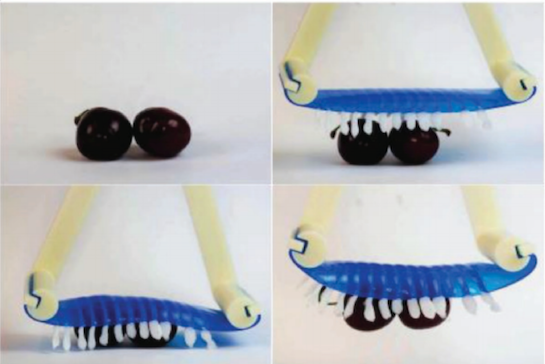
Maral P.S. Mousavi, Alar Ainla, Edward K.W. Tan, Mohamed K. Abd El-Rahman, Yumi Yoshida, Li Yuan, Haakon H. Sigurslid, Nooralhuda Arkan, Mighten C. Yip, Christoffer K. Abrahamsson, Shervanthi Homer-Vanniasinkam, George M. Whitesides Lab on a Chip, 2018, 18, 2279-2290.
LINK TO ARTICLE
Potentiometric sensing of ions with ion-selective electrodes (ISEs) is a powerful technique for selective and sensitive measurement of ions in complex matrices. The application of ISEs is generally limited to laboratory settings, because most commercially available ISEs and reference electrodes are large, delicate, and expensive, and are not suitable for point-of-use or point-of-care measurements. This work utilizes cotton thread as a substrate for fabrication of robust and miniaturized ISEs that are suitable for point-of-care or point-of-use applications. Thread-based ISEs selective for Cl−, K+, Na+, and Ca2+ were developed. The cation-selective ISEs were fabricated by coating the thread with a surfactant-free conductive ink (made of carbon black) and then coating the tip of the conductive thread with the ion-selective membrane. The Cl− ISE was fabricated by coating the thread with an Ag/AgCl ink. These sensors exhibited slopes (of electrical potential vs. log concentration of target ion), close to the theoretically-expected values, over four orders of magnitude in concentrations of ions. Because thread is mechanically strong, the thread-based electrodes can be used in multiple-use applications as well as single-use applications. Multiple thread-based sensors can be easily bundled together to fabricate a customized sensor for multiplexed ion-sensing. These electrodes require volumes of sample as low as 200 μL. The application of thread-based ISEs is demonstrated in the analysis of ions in soil, food, and dietary supplements (Cl− in soil/water slurry, K+ and Na+ in coconut water, and Ca2+ in a calcium supplement), and in detection of physiological electrolytes (K+ and Na+ in blood serum and urine, with sufficient accuracy for clinical diagnostics).
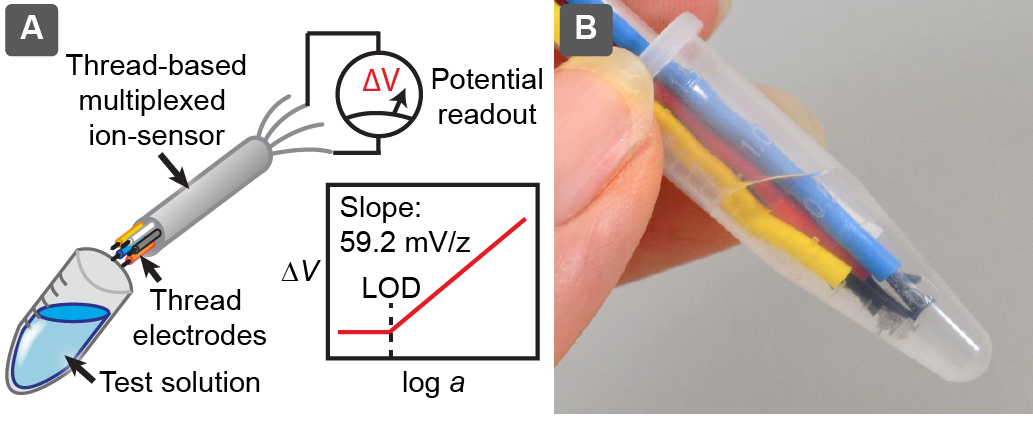
Alar Ainla, Maral P.S. Mousavi, Maria-Nefeli Tsaloglou, Julia Redston, Jeffrey G. Bell, M. Teresa Fernández-Abedul, George M. Whitesides Analytical chemistry, 2018, 90(10), pp. 6240-6246.
LINK TO ARTICLE
This paper describes the design and characterization of an open-source “universal wireless electrochemical detector” (UWED). This detector interfaces with a smartphone (or a tablet) using “Bluetooth Low Energy” protocol; the smartphone provides (i) a user interface for receiving the experimental parameters from the user and visualizing the result in real time, and (ii) a proxy for storing, processing, and transmitting the data and experimental protocols. This approach simplifies the design, and decreases both the size and the cost of the hardware; it also makes the UWED adaptable to different types of analyses by simple modification of the software. The UWED can perform the most common electroanalytical techniques of potentiometry, chronoamperometry, cyclic voltammetry, and square wave voltammetry, with results closely comparable to benchtop commercial potentiostats. Although the operating ranges of electrical current and voltage of the UWED (±1.5 V, ±180 μA) are more limited than most benchtop commercial potentiostats, its functional range is sufficient for most electrochemical analyses in aqueous solutions. Because the UWED is simple, small in size, assembled from inexpensive components, and completely wireless, it offers new opportunities for the development of affordable diagnostics, sensors, and wearable devices.
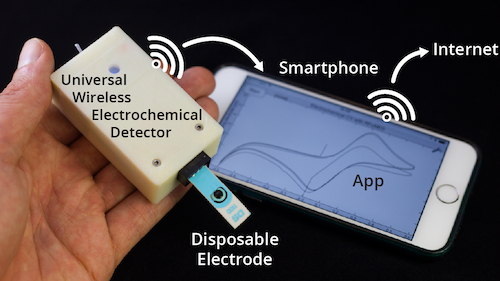
Philipp Rothemund, Alar Ainla, Lee Belding, Daniel J. Preston, Sarah Kurihara, Zhigang Suo, George M Whitesides Science Robotics, 2018, 3(16), eaar7986.
LINK TO ARTICLE
Almost all pneumatic and hydraulic actuators useful for mesoscale functions rely on hard valves for control. This article describes a soft, elastomeric valve that contains a bistable membrane, which acts as a mechanical “switch” to control air flow. A structural instability—often called “snap-through”—enables rapid transition between two stable states of the membrane. The snap-upward pressure, ΔP1 (kilopascals), of the membrane differs from the snap-downward pressure, ΔP2 (kilopascals). The valuesΔP1 and ΔP2 can be designed by changing the geometry and the material of the membrane. The valve does not require power to remain in either “open” or “closed” states (although switching does require energy), can be designed to be bistable, and can remain in either state without further applied pressure. When integrated in a feedback pneumatic circuit, the valve functions as a pneumatic oscillator (between the pressures ΔP1 and ΔP2), generating periodic motion using air from a single source of constant pressure. The valve, as a component of pneumatic circuits, enables (i) a gripper to grasp a ball autonomously and (ii) autonomous earthworm-like locomotion using an air source of constant pressure. These valves are fabricated using straightforward molding and offer a way of integrating simple control and logic functions directly into soft actuators and robots.
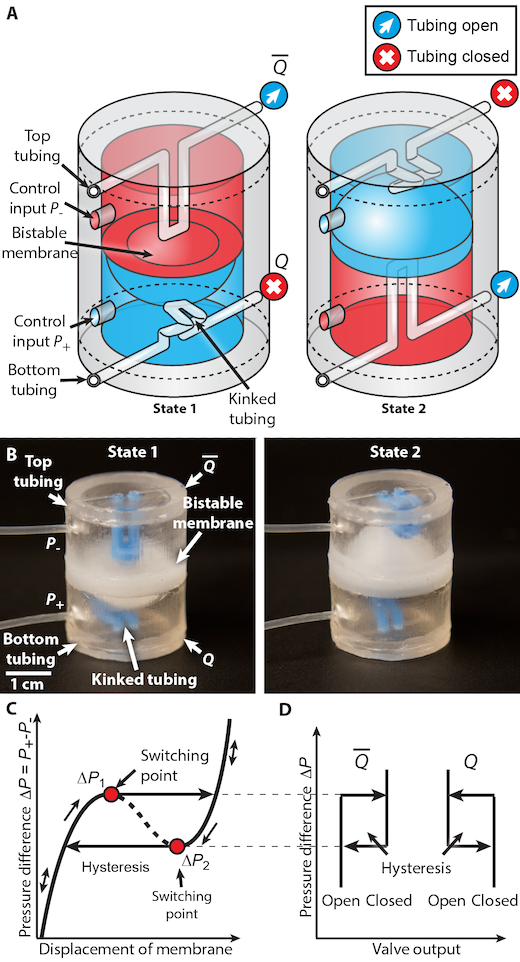
Sergey N. Semenov, Alar Ainla, Ekaterina V. Skorb, Sjoerd G.J. Postma Israel Journal of Chemistry, 2018, 58 (6-7).
LINK TO ARTICLE
This paper describes a four‐variable model for an enzymatic oscillator based on trypsin. Variables in this model are concentrations of the essential proteins (trypsin and trypsinogen) and small molecules (masked and active inhibitors of trypsin) within the network. Importantly, to simplify the model, non‐essential side reactions are neglected and essential reactions are assumed to follow first or second order kinetics. Numerical solutions of this reduced model semi‐quantitatively reproduce experimentally determined periods, amplitudes, and phase shifts of oscillations in the concentrations of several species in the network. Moreover, linear stability analysis shows that oscillations in the trypsin oscillator emerge and disappear through Hopf bifurcation. The model will be helpful in situations where simplicity is necessary such as detailed analysis of dynamics and modeling of reaction‐diffusion systems.
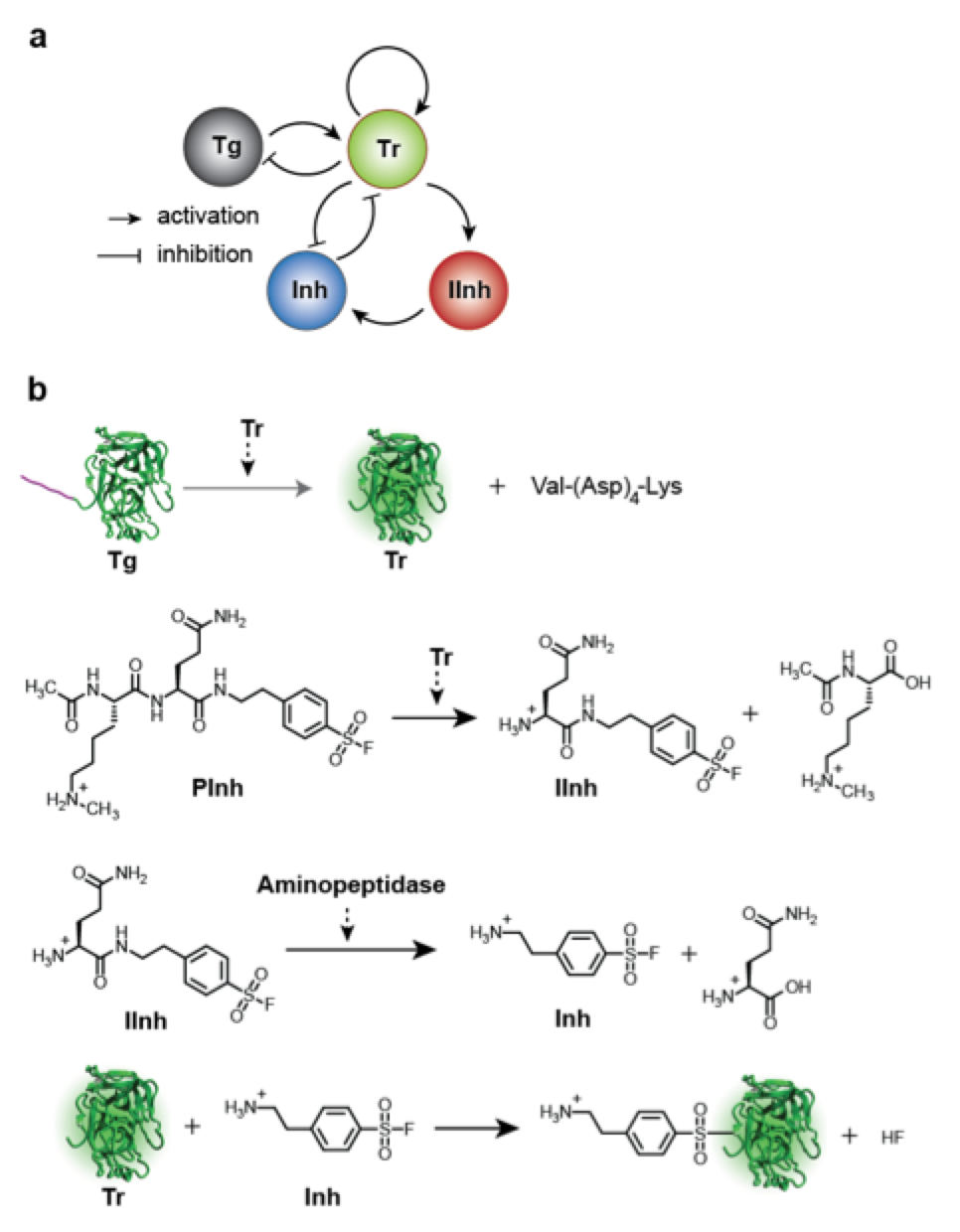
Mohit S. Verma, Alar Ainla, Dian Yang, Daniel Harburg & George M. Whitesides Soft Robotics, 2018, 5(2).
LINK TO ARTICLE
This article demonstrates a pneumatically actuated soft robot capable of navigating the inside of a tube. This robot was built using buckling pneumatic actuators (vacuum-actuated muscle-inspired pneumatic structures, or VAMPs). The tube climber can navigate through a tube with turns, inclines, and varying diameters. The robot is also able to remove obstacles (of more than 10 times its own weight) from tubes to perform a clearing function. It maintains climbing and clearing performance in wet conditions and under water. The tube climber is lightweight and completely soft and thus has the potential to be collaborative (i.e., work with humans) and also to interact safely with delicate environments.

Alar Ainla, Mahiar M. Hamedi, Firat Güder, George M. Whitesides Advanced Materials, 2017, 29, 38 1702894.
LINK TO ARTICLE
This paper describes electrically-activated fluidic valves that operate based on electrowetting through textiles. The valves are fabricated from electrically conductive, insulated, hydrophobic textiles, but the concept can be extended to other porous materials. When the valve is closed, the liquid cannot pass through the hydrophobic textile. Upon application of a potential (in the range of 100–1000 V) between the textile and the liquid, the valve opens and the liquid penetrates the textile. These valves actuate in less than 1 s, require low energy (≈27 µJ per actuation), and work with a variety of aqueous solutions, including those with low surface tension and those containing bioanalytes. They are bistable in function, and are, in a sense, the electrofluidic analog of thyristors. They can be integrated into paper microfluidic devices to make circuits that are capable of controlling liquid, including autonomous fluidic timers and fluidic logic.
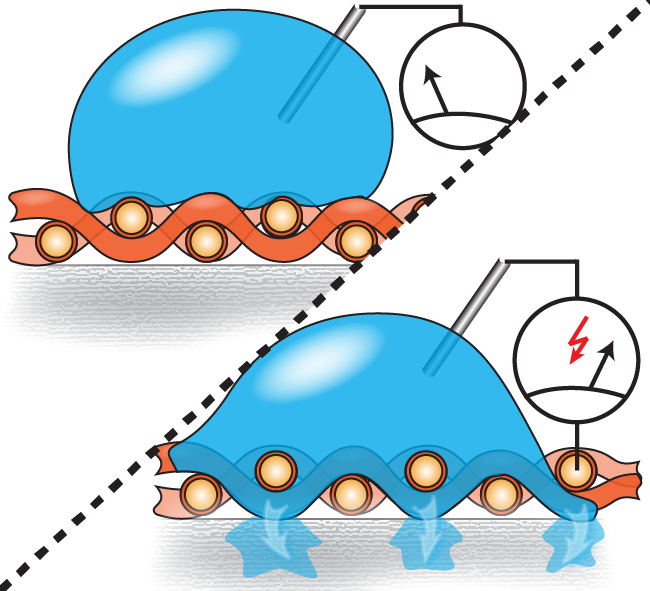
Alar Ainla, Mohit S. Verma, Dian Yang & George M. Whitesides Soft Robotics, 2017, 4(3).
LINK TO ARTICLE
This article describes a soft pneumatic actuator that generates cyclical motion. The actuator consists of several (three, four, or five) chambers (arranged around the circumference of a circle surrounding a central rod) that can be actuated independently using negative pressure (or partial vacuum). Sequential actuation of the four-chamber device using reduced pressure moves the central rod cyclically in an approximately square path. We characterize the trajectory of the actuator and the force exerted by it, as we vary the material used for fabrication, the number of chambers, and the size of the actuator. We demonstrate two applications of this actuator: to deliver fluid while stirring (by replacing the central rod with a needle) and for locomotion that mimics a reptilian gait (by combining four actuators together).
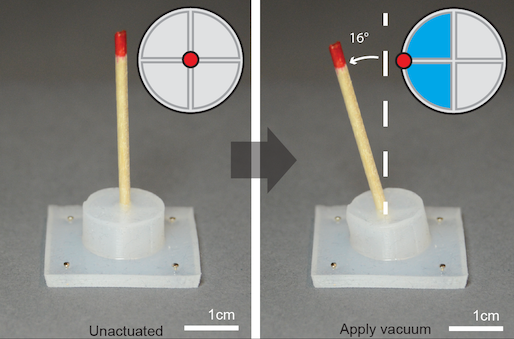
Alex Nemiroski, Yanina Y. Shevchenko, Adam A. Stokes, Baris Unal, Alar Ainla, Sahradha Albert, Gabrielle Compton, Emily MacDonald, Yosyp Schwab, Caroline Zellhofer & George M. Whitesides Soft Robotics, 2017, 4(3).
LINK TO ARTICLE
This article describes a class of robots—“arthrobots”—inspired, in part, by the musculoskeletal system of arthropods (spiders and insects, inter alia). Arthrobots combine mechanical compliance, lightweight and simple construction, and inexpensive yet scalable design. An exoskeleton, constructed from thin organic polymeric tubes, provides lightweight structural support. Pneumatic joints modeled after the hydrostatic joints of spiders provide actuation and inherent mechanical compliance to external forces. An inflatable elastomeric tube (a “balloon”) enables active extension of a limb; an opposing elastic tendon enables passive retraction. A variety of robots constructed from these structural elements demonstrate (i) crawling with one or two limbs, (ii) walking with four or six limbs (including an insect-like triangular gait), (iii) walking with eight limbs, or (iv) floating and rowing on the surface of water. Arthrobots are simple to fabricate and are able to operate safely in contact with humans.
Media coverage by: Harvard gazette, Gizmodo, BBC World News
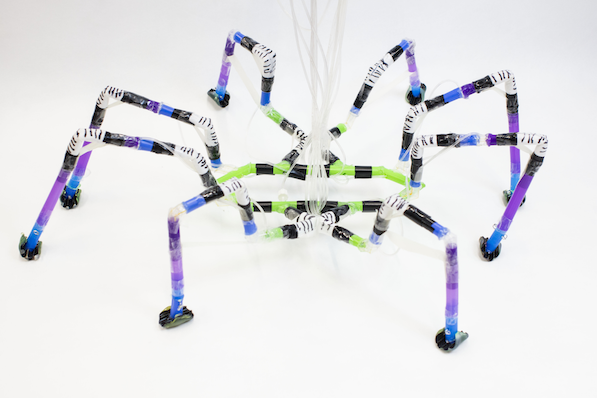
Anna A. Kim, Kiryl Kustanovich, Davod Baratian, Alar Ainla, Mehrnas Shaali, Gavin D. M. Jeffries & Aldo Jesorka Biomicrofluidics, 2017, 11, 014112.
LINK TO ARTICLE
We present a process for fabrication of free-standing SU-8 probes, with a dry, mechanical release of the final micro-devices. The process utilizes the thermal release tape, a commonly used cleanroom material, for facile heat-release from the sacrificial layer. For characterization of the SU-8 microfluidic probes, two liquid interfaces were designed: a disposable interface with integrated wells and an interface with external liquid reservoirs. The versatility of the fabrication and the release procedures was illustrated by further developing the process to functionalize the SU-8 probes for impedance sensing, by integrating metal thin-film electrodes. An additional interface scheme which contains electronic components for impedance measurements was developed. We investigated the possibilities of introducing perforations in the SU-8 device by photolithography, for solution sampling predominantly by diffusion. The SU-8 processes described here allow for a convenient batch production of versatile free-standing microfluidic devices with well-defined tip-geometry.
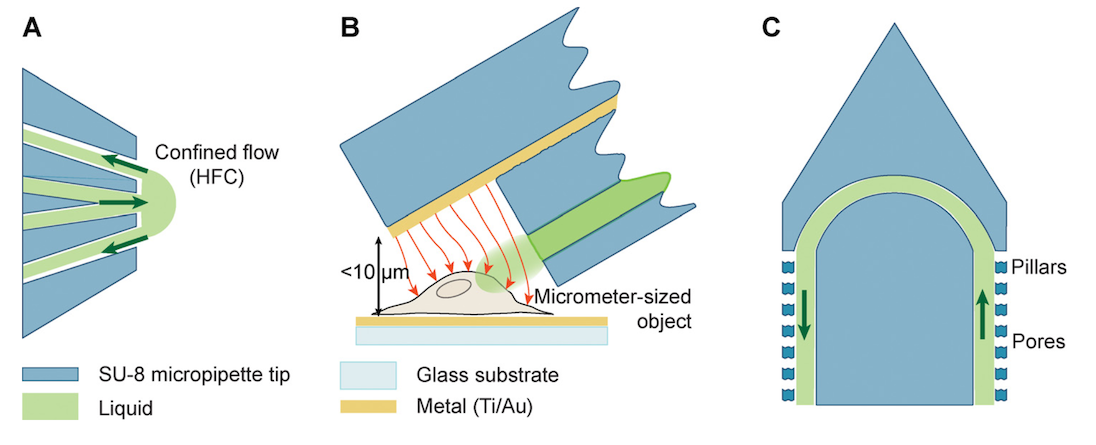
Sergey N. Semenov, Lewis J. Kraft, Alar Ainla, Mengxia Zhao, Mostafa Baghbanzadeh, Victoria E. Campbell, Kyungtae Kang, Jerome M. Fox & George M. Whitesides Nature, 2016, 537, pp. 656-660.
LINK TO ARTICLE
Networks of organic chemical reactions are important in life and probably played a central part in its origin. Network dynamics regulate cell division, circadian rhythms, nerve impulses and chemotaxis, and guide the development of organisms. Although out-of-equilibrium networks of chemical reactions have the potential to display emergent network dynamics such as spontaneous pattern formation, bistability and periodic oscillations, the principles that enable networks of organic reactions to develop complex behaviours are incompletely understood. Here we describe a network of biologically relevant organic reactions (amide formation, thiolate-thioester exchange, thiolate-disulfide interchange and conjugate addition) that displays bistability and oscillations in the concentrations of organic thiols and amides. Oscillations arise from the interaction between three subcomponents of the network: an autocatalytic cycle that generates thiols and amides from thioesters and dialkyl disulfdes; a trigger that controls autocatalytic growth; and inhibitory processes that remove activating thiol species that are produced during the autocatalytic cycle. In contrast to previous studies that have demonstrated oscillations and bistability using highly evolved biomolecules (enzymes and DNA) or inorganic molecules of questionable biochemical relevance (for example, those used in Belousov-Zhabotinskii-type reactions) the organic molecules we use are relevant to metabolism and similar to those that might have existed on the early Earth. By using small organic molecules to build a network of organic reactions with autocatalytic, bistable and oscillatory behaviour, we identify principles that explain the ways in which dynamic networks relevant to life could have developed. Modifications of this network will clarify the influence of molecular structure on the dynamics of reaction networks, and may enable the design of biomimetic networks and of synthetic self-regulating and evolving chemical systems.
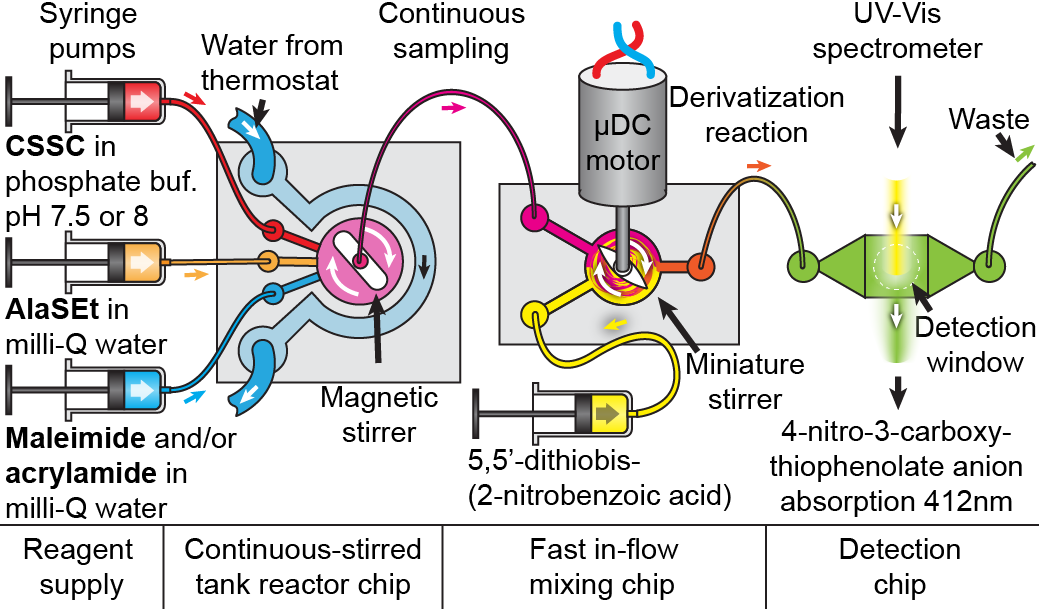
Chien-Chung Wang, Jonathan W. Hennek, Alar Ainla, Ashok A. Kumar, Wen-Jie Lan, Judy Im, Barbara S. Smith, Mengxia Zhao & George M. Whitesides Analytical Chemistry, 2016, 88(12), pp. 6326-6333.
LINK TO ARTICLE
This paper describes the design and fabrication of a "pop-up" electrochemical paper-based analytical device (pop-up-EPAD) to measure beta-hydroxybutyrate (BHB)-a biomarker for diabetic ketoacidosis-using a commercial combination BHB/glucometer. Pop-up-EPADs are inspired by pop-up greeting cards and children's books. They are made from a single sheet of paper folded into a three-dimensional (3D) device that changes shape, and fluidic and electrical connectivity, by simply folding and unfolding the structure. The reconfigurable 3D structure makes it possible to change the fluidic path and to control timing; it also provides mechanical support for the folded and unfolded structures that enables good registration and repeatability on folding. A pop-up-EPAD designed to detect BHB shows performance comparable to commercially available plastic test strips over the clinically relevant range of BHB in blood when used with a commercial glucometer that integrates the ability to measure glucose and BHB (combination BHB/glucometer). With simple modifications of the electrode and the design of the fluidic path, the pop-up-EPAD also detects BHB in buffer using a simple glucometer-a device that is more available than the combination BHB/glucometer. Strategies that use a "3D pop-up"-that is, large-scale changes in 3D structure and fluidic paths-by folding/unfolding add functionality to EPADs (e.g., controlled timing, fluidic handling and path programming, control over complex sequences of steps, and alterations in electrical connectivity) and should enable the development of new classes of paper-based diagnostic devices.
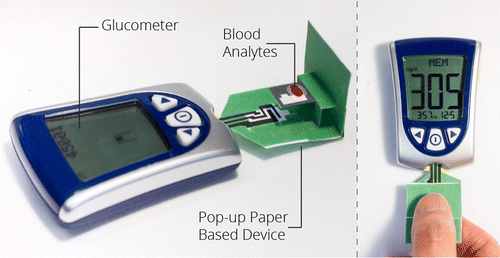
Mahiar M. Hamedi, Alar Ainla, Dionysios C. Christodouleas, M. Teresa Fernandez-Abedul & George M. Whitesides Advanced Materials, 2016, 28(25), pp. 5054-5063.
LINK TO ARTICLE
Paper microfluidics and printed electronics have developed independently, and are incompatible in many aspects. This work demonstrates monolithic integration of microfluidics and electronics on paper. This integration makes it possible to print two- and 3D fluidic, electrofluidic, and electrical components on paper, and to fabricate devices using them.
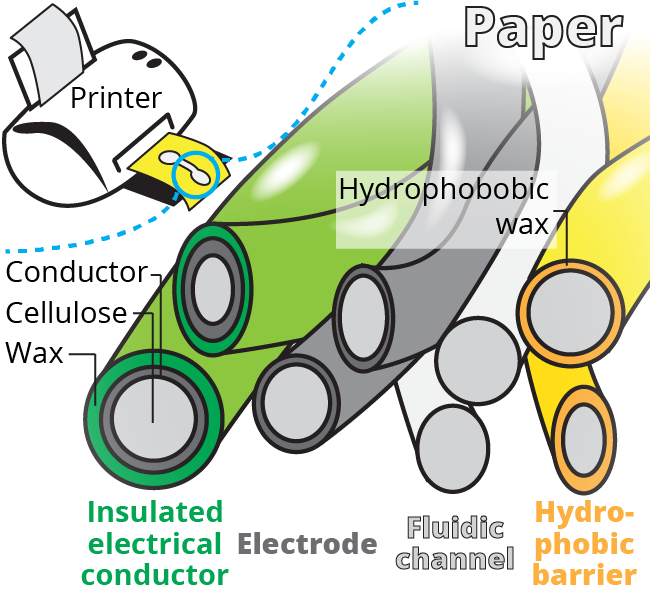
Firat Guder, Alar Ainla, Julia Redston, Bobak Mosadegh, Ana Glavan, T.J. Martin & George M. Whitesides Angewandte Chemie International Edition, 2016, 55(19), pp. 5727-5732.
LINK TO ARTICLE
Current methods of monitoring breathing require cumbersome, inconvenient, and often expensive devices; this requirement sets practical limitations on the frequency and duration of measurements. This article describes a paper-based moisture sensor that uses the hygroscopic character of paper (i.e. the ability of paper to adsorb water reversibly from the surrounding environment) to measure patterns and rate of respiration by converting the changes in humidity caused by cycles of inhalation and exhalation to electrical signals. The changing level of humidity that occurs in a cycle causes a corresponding change in the ionic conductivity of the sensor, which can be measured electrically. By combining the paper sensor with conventional electronics, data concerning respiration can be transmitted to a nearby smartphone or tablet computer for post-processing, and subsequently to a cloud server. This means of sensing provides a new, practical method of recording and analyzing patterns of breathing.
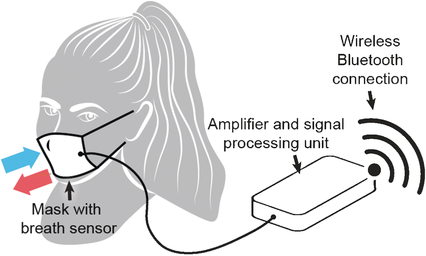
Dian Yang, Bobak Mosadegh, Alar Ainla, Benjamin Lee, Fatemeh Khashai, Zhigang Suo, Katia Bertoldi & George M. Whitesides. Advanced Materials 2015, 27 (41), pp 6323-6327.
LINK TO ARTICLE
Soft, pneumatic actuators that buckle when interior pressure is less than exterior provide a new mechanism of actuation. Upon application of negative pneumatic pressure, elastic beam elements in these actuators undergo reversible, cooperative collapse, and generate a rotational motion. These actuators are inexpensive to fabricate, lightweight, easy to control, and safe to operate. They can be used in devices that manipulate objects, locomote, or interact cooperatively with humans.
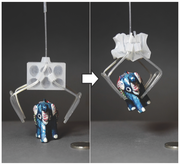
Ana C. Glavan, Alar Ainla, Mahiar M. Hamedi, M. Teresa Fernandez-Abedul & George M. Whitesides. Lab on a Chip 2016, 16, pp 112-119.
LINK TO ARTICLE
This work describes the adaptive use of conventional stainless steel pins-used in unmodified form or coated with carbon paste-as working, counter, and quasi-reference electrodes in electrochemical devices fabricated using cotton thread or embossed omniphobic RF paper to contain the electrolyte and sample. For some applications, these pin electrodes may be easier to modify and use than printed electrodes, and their position and orientation can be changed as needed. Electroanalytical devices capable of multiplex analysis (thread-based arrays or 96-well plates) were easily fabricated using pins as electrodes in either thread or omniphobic RF paper.
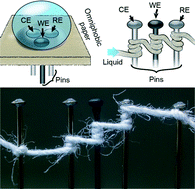
Shijun Xu, Alar Ainla, Kent Jardemark, Aldo Jesorka & Gavin D. M. Jeffries. Analytical Chemistry 2015, 87 (1), pp 381–387.
LINK TO ARTICLE
Here, we report on a novel approach for the study of single-cell intracellular enzyme activity at various temperatures, utilizing a localized laser heating probe in combination with a freely positionable microfluidic perfusion device. Through directed exposure of individual cells to the pore-forming agent α-hemolysin, we have controlled the membrane permeability, enabling targeted delivery of the substrate. Mildly permeabilized cells were exposed to fluorogenic substrates to monitor the activity of intracellular enzymes, while adjusting the local temperature surrounding the target cells, using an infrared laser heating system. We generated quantitative estimates for the intracellular alkaline phosphatase activity at five different temperatures in different cell lines, constructing temperature-response curves of enzymatic activity at the single-cell level. Enzymatic activity was determined rapidly after cell permeation, generating five-point temperature-response curves within just 200 s.
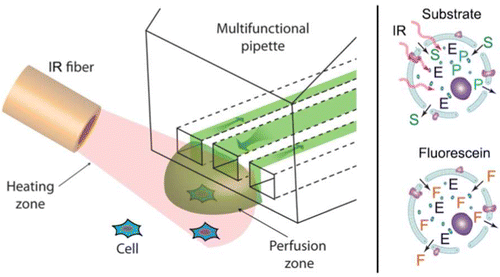
Aikeremu Ahemaiti, Holger Wigström, Alar Ainla, Gavin D.M. Jeffries, Owe Orwar, Aldo Jesorka & Kent Jardemark. Journal of Neuroscience Methods 2015, 241, pp 132-136.
LINK TO ARTICLE
Highlights
* A microfluidic device for localized drug perfusion to brain slices is presented.
* The tool utilized hydrodynamically confined flow for localized drug delivery.
* The drug delivery efficiency of the tool is comparable with whole slice perfusion.
* he tool requires orders of magnitude less drugs than whole slice perfusion.
* he tool can be used in combination with other probing and imaging techniques.
Mehrnaz Shaali, Samuel Lara-Avila, Paul Dommersnes, Alar Ainla, Sergey Kubatkin & Aldo Jesorka. ACS Nano 2015, 9 (2), pp 1271-1279.
LINK TO ARTICLE
Direct electron-beam lithography is used to fabricate nanostructured Teflon AF surfaces, which are utilized to pattern surface-supported monolayer phospholipid films with 50 nm lateral feature size. In comparison with unexposed Teflon AF coatings, e-beam-irradiated areas show reduced surface tension and surface potential. For phospholipid monolayer spreading experiments, these areas can be designed to function as barriers that enclose unexposed areas of nanometer dimensions and confine the lipid film within. We show that the effectiveness of the barrier is defined by pattern geometry and radiation dose. This surface preparation technique represents an efficient, yet simple, nanopatterning strategy supporting studies of lipid monolayer behavior in ultraconfined spaces. The generated structures are useful for imaging studies of biomimetic membranes and other specialized surface applications requiring spatially controlled formation of self-assembled, molecularly thin films on optically transparent patterned polymer surfaces with very low autofluorescence.
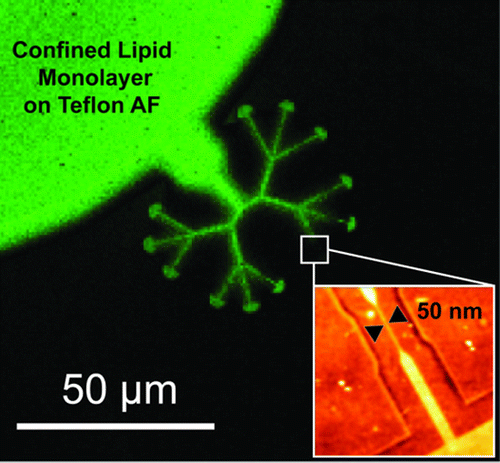
Alar Ainla, Irep Gözen, Bodil Hakonen & Aldo Jesorka. Scientific Reports, 2013, 3, 2743.
LINK TO ARTICLE
Lipid bilayer membranes are among the most ubiquitous structures in the living world, with intricate structural features and a multitude of biological functions. It is attractive to recreate these structures in the laboratory, as this allows mimicking and studying the properties of biomembranes and their constituents, and to specifically exploit the intrinsic two-dimensional fluidity. Even though diverse strategies for membrane fabrication have been reported, the development of related applications and technologies has been hindered by the unavailability of both versatile and simple methods. Here we report a rapid prototyping technology for two-dimensional fluidic devices, based on in-situ generated circuits of phospholipid films. In this "lab on a molecularly thin membrane", various chemical and physical operations, such as writing, erasing, functionalization, and molecular transport, can be applied to user-defined regions of a membrane circuit. This concept is an enabling technology for research on molecular membranes and their technological use.
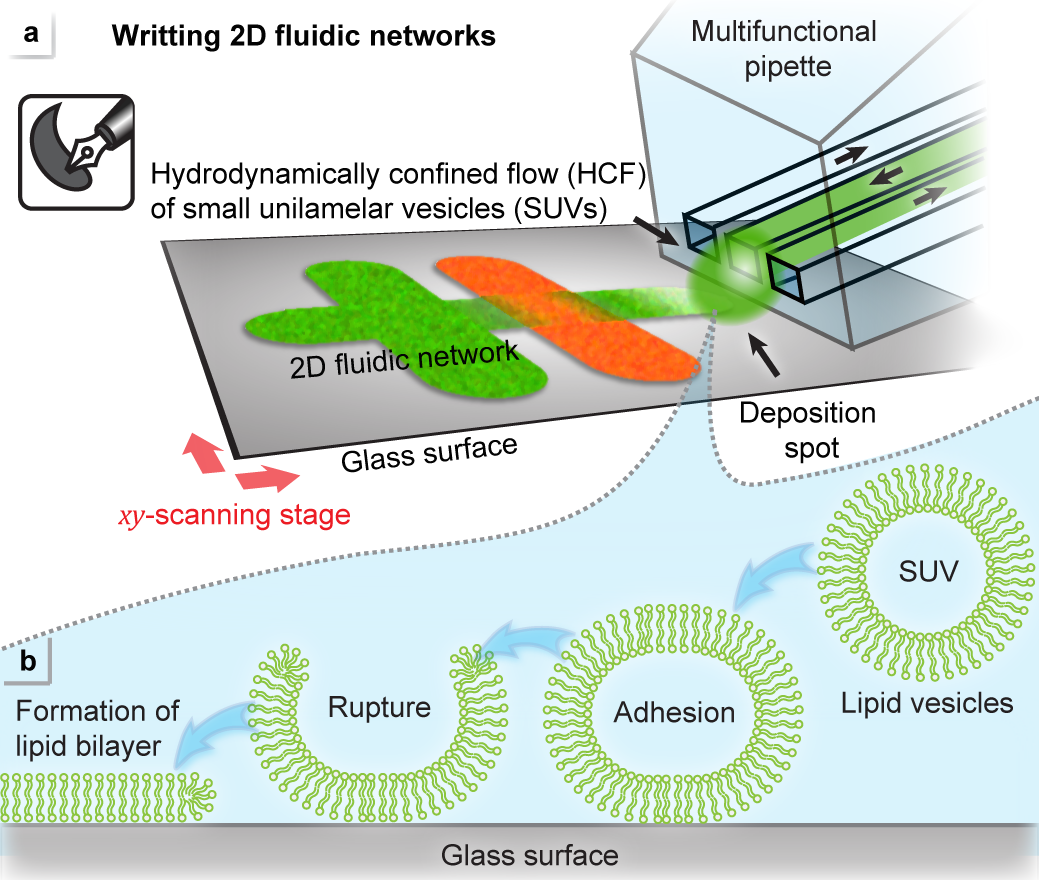
Aikeremu Ahemaiti, Alar Ainla, Gavin D. M. Jeffries, Holger Wigström, Owe Orwar, Aldo Jesorka & Kent Jardemark. Journal of Neuroscience Methods, 2013, 219(2), 292-296.
LINK TO ARTICLE
We have developed a superfusion method utilizing an open-volume microfluidic device for administration of pharmacologically active substances to selected areas in brain slices with high spatio-temporal resolution. The method consists of a hydrodynamically confined flow of the active chemical compound, which locally stimulates neurons in brain slices, applied in conjunction with electrophysiological recording techniques to analyze the response. The microfluidic device, which is a novel free-standing multifunctional pipette, allows diverse superfusion experiments, such as testing the effects of different concentrations of drugs or drug candidates on neurons in different cell layers with high positional accuracy, affecting only a small number of cells. We demonstrate herein the use of the method with electrophysiological recordings of pyramidal cells in hippocampal and prefrontal cortex brain slices from rats, determine the dependence of electric responses on the distance of the superfusion device from the recording site, document a multifold gain in solution exchange time as compared to whole slice perfusion, and show that the device is able to store and deliver up to four solutions in a series. Localized solution delivery by means of open-volume microfluidic technology also reduces reagent consumption and tissue culture expenses significantly, while allowing more data to be collected from a single tissue slice, thus reducing the number of laboratory animals to be sacrificed for a study.
Irep Gözen, Mehrnaz Shaali, Alar Ainla, Bahanur Ortmen, Inga Põldsalu, Kiryl Kustanovich, Gavin D. M. Jeffries, Paul Dommersnes, Zoran Konkoli & Aldo Jesorka. Lab on a Chip, , 2013, 13 (19), 3822-3826.
LINK TO ARTICLE
We demonstrate the contactless generation of lipid nanotube networks by means of thermally induced migration of flat giant unilamellar vesicles (FGUVs), covering micro-scale areas on oxidized aluminum surfaces. A temperature gradient with a reach of 20 μm was generated using a focused IR laser, leading to a surface adhesion gradient, along which FGUVs could be relocated. We report on suitable lipid–substrate combinations, highlighting the critical importance of the electrostatic interactions between the engineered substrate and the membrane for reversible migration of intact vesicles.
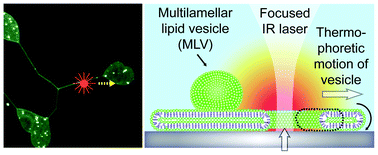
Ilona Węgrzyn, Alar Ainla, Gavin D. M. Jeffries & Aldo Jesorka. Sensors, 2013, 13(4), 4289-4302.
LINK TO ARTICLE
We report the application of a microfluidic device for semi-contact temperature measurement in picoliter volumes of aqueous media. Our device, a freely positionable multifunctional pipette, operates by a hydrodynamic confinement principle, i.e., by creating a virtual flow cell of micrometer dimensions within a greater aqueous volume. We utilized two fluorescent rhodamines, which exhibit different fluorescent responses with temperature, and made ratiometric intensity measurements. The temperature dependence of the intensity ratio was calibrated and used in a model study of the thermal activation of TRPV1 ion channels expressed in Chinese hamster ovary cells. Our approach represents a practical and robust solution to the specific problem of measuring temperature in biological experiments in vitro, involving highly localized heat generation, for example with an IR-B laser.
Alar Ainla, Shijun Xu, Nicolas Sanchez, Gavin D. M. Jeffries & Aldo Jesorka. Lab on a Chip, 2012, 12(22), 4605-4609.
LINK TO ARTICLE
We present here a novel platform combination, using a multifunctional pipette to individually electroporate single-cells and to locally deliver an analyte, while in their culture environment. We demonstrate a method to fabricate low-resistance metallic electrodes into a PDMS pipette, followed by characterization of its effectiveness, benefits and limits in comparison with an external carbon microelectrode.
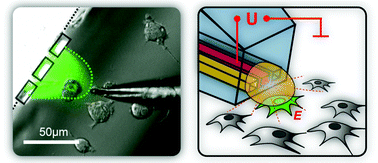
Alar Ainla, Gavin D. M. Jeffries, Ralf Brune, Owe Orwar & Aldo Jesorka . Lab on a Chip, 2012, 12(7), 1255-1261.
LINK TO ARTICLE
Presented work was elected to top 10% technologies of Lab on a Chip
Microfluidics has emerged as a powerful laboratory toolbox for biologists, allowing manipulation and analysis of processes at a cellular and sub-cellular level, through utilization of microfabricated features at size-scales relevant to that of a single cell. In the majority of microfluidic devices, sample processing and analysis occur within closed microchannels, imposing restrictions on sample preparation and use. We present an optimized non-contact open-volume microfluidic tool to overcome these and other restrictions, through the use of a hydrodynamically confined microflow pipette, serving as a multifunctional solution handling and dispensing tool. The geometries of the tool have been optimised for use in optical microscopy, with integrated solution reservoirs to reduce reagent use, contamination risks and cleaning requirements. Device performance was characterised using both epifluorescence and total internal reflection fluorescence (TIRF) microscopy, resulting in ∼200 ms and ∼130 ms exchange times at ∼100 nm and ∼30 μm distances to the surface respectively.
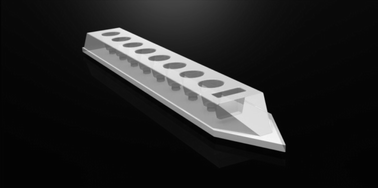
Alar Ainla, Erik T. Jansson, Natalia Stepanyants, Owe Orwar & Aldo Jesorka. Analytical Chemistry, 2010, 82(11), 4529-4536.
LINK TO ARTICLE
We report on a free-standing microfluidic pipette made in poly(dimethylsiloxane) having a circulating liquid tip that generates a self-confining volume in front of the outlet channels. The method is flexible and scalable as the geometry and the size of the recirculation zone is defined by pressure, channel number, and geometry. The pipette is capable of carrying out a variety of complex fluid processing operations, such as mixing, multiplexing, or gradient generation at selected cells in cell and tissue cultures. Using an uptake assay, we show that it is possible to generate dose−response curves in situ from adherent Chinese hamster ovary cells expressing proton-activated human transient receptor potential vanilloid (hTRPV1) receptors. Using confined superfusion and cell stimulation, we could activate hTRPV1 receptors in single cells, measure the response by a patch-clamp pipette, and induce membrane bleb formation by exposing selected groups of cells to formaldehyde/dithiothreitol-containing solutions, respectively. In short, the microfluidic pipette allows for complex, contamination-free multiple-compound delivery for pharmacological screening of intact adherent cells.
Alar Ainla, Irep Gözen, Owe Orwar & Aldo Jesorka. Analytical Chemistry, 2009, 81(13), 5549-5556.
LINK TO ARTICLE
We demonstrate that pulse width flow modulation (PWFM) can be used to design fast, accurate, and precise multistage dilution modules for microfluidic devices. The PWFM stage unit presented here yields 10-fold dilution, but several PWFM stages can be connected in series to yield higher-order dilutions. We have combined two stages in a device thus capable of diluting up to 100-fold, and we have experimentally determined a set of rules that can be conveniently utilized to design multistage diluters. Microfabrication with resist-based molds yielded geometrical channel height variances of 7% (22.9(16) μm) with corresponding hydraulic resistance variances of ∼20%. Pulsing frequencies, channel lengths, and flow pressures can be chosen within a wide range to establish the desired diluter properties. Finally, we illustrate the benefits of on-chip dilution in an example application where we investigate the effect of the Ca2+ concentration on a phospholipid bilayer spreading from a membrane reservoir onto a SiO2 surface. This is one of many possible applications where flexible concentration control is desirable.
Alar Ainla & Daniel Brandell. Solid State Ionics, 2007 (178) 7-10, s. 581-585.
LINK TO ARTICLE
Nafion®–PBI composites were prepared by diffusing synthesized PBI from solution phase into Nafion® membranes, using different concentrations and drying temperatures. In some cases, Nafion® was treated with diethyl amine to screen the –SO3H groups and thereby avoid the strong acid–base interactions between the polymers during diffusion. The presence of PBI in the membranes was characterized with FT–IR spectroscopy. The performance of the membranes was studied by in-plane conductivity and methanol permeability. The performance ratio (the ratio between conductivity and methanol permeability compared to Nafion®) increased by up to 50% for the composite membranes compared to Nafion®.
Peer-Reviewed Conference Contributions
Emanuel Sousa, Nuno Sousa, Rosane Sampaio, Joana Vieira, Marcelo Pires, Diogo Aguiam, Alar Ainla, João Gaspar, Gabriel Ribeiro, Edoardo Sotgiu. 2021 IEEE World Haptics Conference (WHC), 2021.
LINK TO ARTICLE
Product-in-Touch is an ongoing R&D project for developing a virtual reality application for prototyping in-car textures, providing both visual and haptic input to a user. The device will allow designers to virtually prototype textured surfaces, both in terms of visual and haptic perception, without the need for physical prototypes.
Andreas Genner, Alar Ainla & Aldo Jesorka. Proceedings of the 3rd International Workshop on Soft Matter Physics & Complex Flows. Ed.: Jon Otto Fossum and Elisabeth Bouchaud. Lofoten, Norway.
LINK TO ARTICLE
We have successfully implemented an improved PWFM diluter into the microfluidic pipette platform, highlighting the multifunctionality aspect as a core concept. The main technical improvements are much faster on-off switching of output of the diluter with a time constant of much less than 200 ms, and the ability to dilute two compounds simultaneously. The dilution process is computer-controlled, featuring automated calibration of the diluting stages, and arbitrary concentration sequences at the output of the microfluidic device.
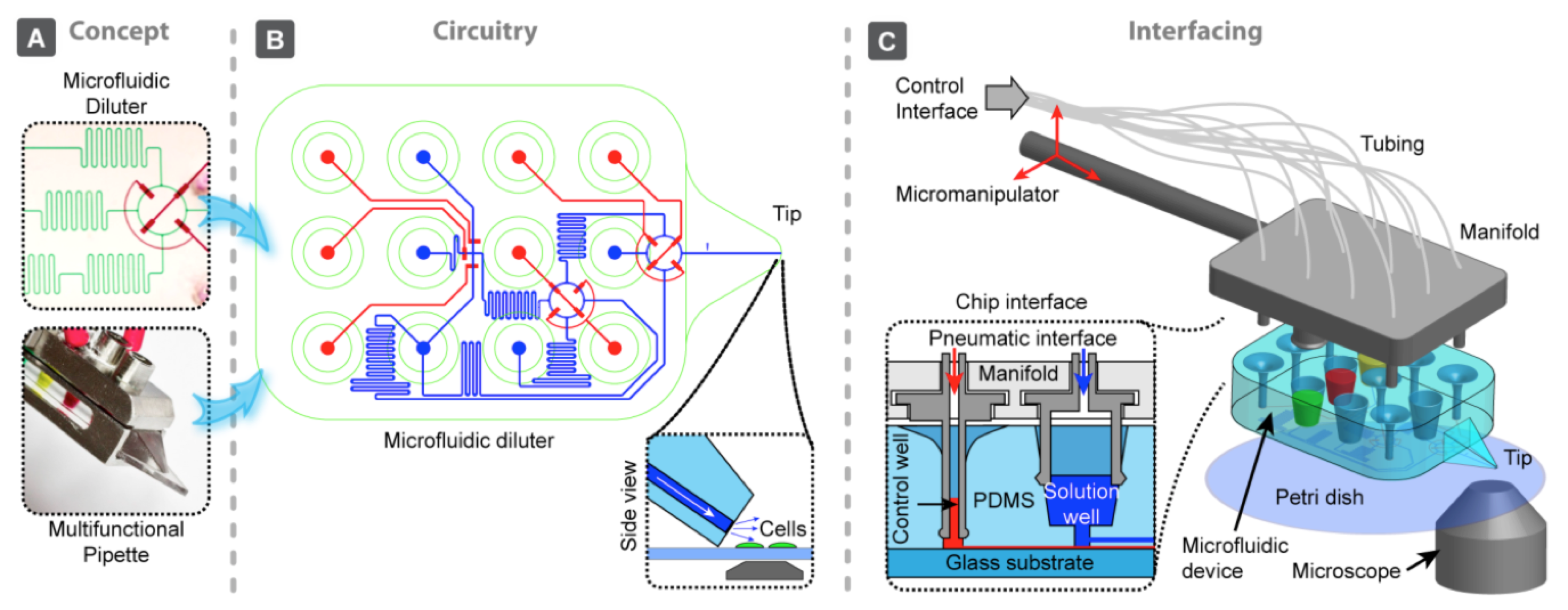
Alar Ainla, Erik T. Jansson, Natalia Stepanyants, Owe Orwar & Aldo Jesorka. Proceedings of µTAS2010, Groningen, The Neatherlands.
LINK TO ARTICLE
We report a multi-purpose microfluidic pipette, with a recirculating liquid tip. This device, made in poly(dimethylsiloxane), enables contamination-free manipulation and chemical stimulation of selected single cells in cell collectives or tissue slices. The pipette is capable of carrying out a variety of complex fluid processing functionalities, such as mixing, multiplexing, or gradient generation. The concept is flexible and scalable as the geometry and the size of the recirculation zone is defined by pressure, channel number, and geometry. We have applied the pipette in a fluorescence uptake assay, electrophysiology studies and for chemical induction of membrane protrusion from biological cells.
Daniel Brandell, Alar Ainla, Anti Liivat & Alvo Aabloo. Smart Structures and Materials 2006: Electroactive Polymer Actuators and Devices (EAPAD), Proc. SPIE Vol. 6168, p. 118-126.
LINK TO ARTICLE
Molecular Dynamics (MD) techniques have been used to study the structure and dynamics of hydrated Li- and Na-Nafion membranes. The membranes were generated using a Monte Carlo-approach for Nafion 117 oligomers of Mw = 1100 and with water contents of 7.5 and 20 % by weight, equivalent to 5 and 15 water molecules per sulfonate group, respectively. After equilibration, local structural properties and dynamical features such as coordination, cluster stability, solvation and ion conductivity were studied. In a comparison between the two cationic systems, it is shown that the Na-Nafion system is more sensitive than Li-Nafion to the level of hydration, and also show higher ion conductivity. The ionic conductivity is shown to increase with higher level of hydration.
Review Articles & Book Chapters
Alexandra Teixeira, Adriana Carneiro, Paulina Piairo, Miguel Xavier, Alar Ainla, Cláudia Lopes, Maria Sousa-Silva, Armando Dias, Ana S Martins, Carolina Rodrigues, Ricardo Pereira, Liliana R Pires, Sara Abalde-Cela, Lorena Diéguez. Chapter in book "Microfluidics and Biosensors in Cancer Research", 2022, 553-590.
LINK TO ARTICLE
In recent years, we have seen major advances in the field of liquid biopsy and its implementation in the clinic, mainly driven by breakthrough developments in the area of molecular biology. New developments have seen an integration of microfluidics and also biosensors in liquid biopsy systems, bringing advantages in terms of cost, sensitivity and automation. Without a doubt, the next decade will bring the clinical validation and approval of these combined solutions, which is expected to be crucial for the wide implementation of liquid biopsy systems in clinical routine.
Micaela Oliveira, Pedro Conceição, Krishna Kant, Alar Ainla, Lorena Diéguez
LINK TO ARTICLE
Currently, conventional pre-clinical in vitro studies are primarily based on two-dimensional (2D) cell culture models, which are usually limited in mimicking the real three-dimensional (3D) physiological conditions, cell heterogeneity, cell to cell interaction, and extracellular matrix (ECM) present in living tissues. Traditionally, animal models are used to mimic the 3D environment of tissues and organs, but they suffer from high costs, are time consuming, bring up ethical concerns, and still present many differences when compared to the human body. The applications of microfluidic-based 3D cell culture models are advantageous and useful as they include 3D multicellular model systems (MCMS). These models have demonstrated potential to simulate the in vivo 3D microenvironment with relatively low cost and high throughput. The incorporation of monitoring capabilities in the MCMS has also been explored to evaluate in real time biophysical and chemical parameters of the system, for example temperature, oxygen, pH, and metabolites. Electrochemical sensing is considered as one of the most sensitive and commercially adapted technologies for bio-sensing applications. Amalgamation of electrochemical biosensing with cell culture in microfluidic devices with improved sensitivity and performance are the future of 3D systems. Particularly in cancer, such models with integrated sensing capabilities can be crucial to assess the multiple parameters involved in tumour formation, proliferation, and invasion. In this review, we are focusing on existing 3D cell culture systems with integrated electrochemical sensing for potential applications in cancer models to advance diagnosis and treatment. We discuss their design, sensing principle, and application in the biomedical area to understand the potential relevance of miniaturized electrochemical hybrid systems for the next generation of diagnostic platforms for precision medicine.
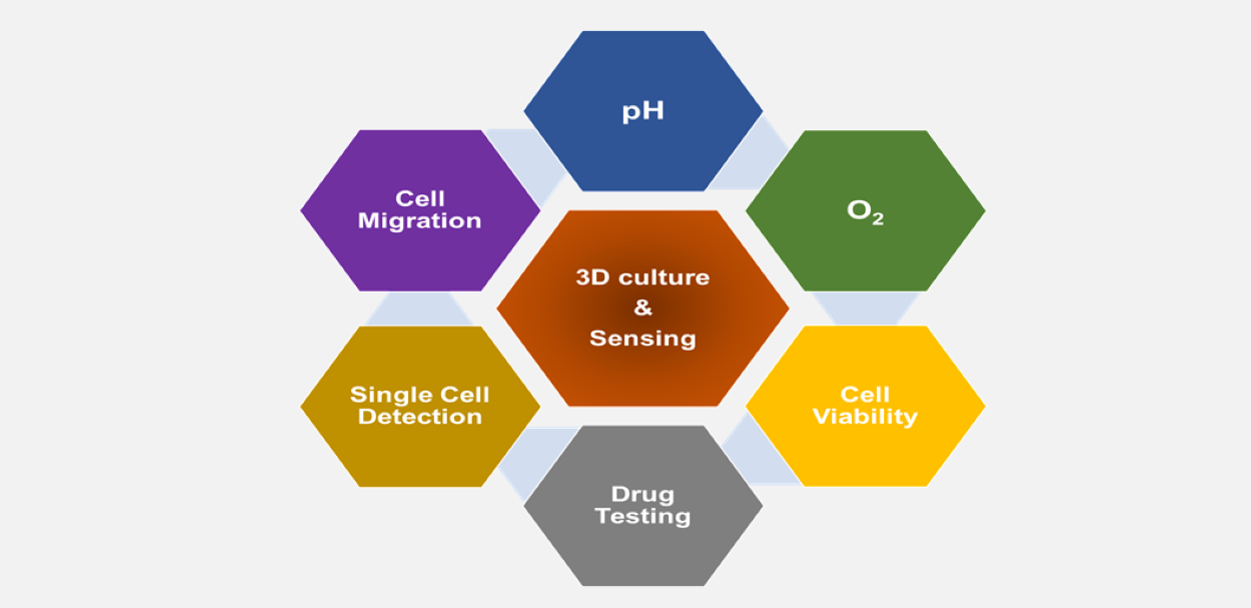
Alar Ainla, Gavin D. M. Jeffries & Aldo Jesorka. Micromachines 2012, 3(2), 442-461. (REVIEW).
LINK TO ARTICLE
Hydrodynamically confined flow device technology is a young research area with high practical application potential in surface processing, assay development, and in various areas of single cell research. Several variants have been developed, and most recently, theoretical and conceptual studies, as well as fully developed automated systems, were presented. In this article we review concepts, fabrication strategies, and application areas of hydrodynamically confined flow (HCF) devices.
Alar Ainla, Gavin D. M. Jeffries & Aldo Jesorka. Chapter In book "Hydrodynamics – Theory and Model", by Jinhai Zheng, InTech, 2012, ISBN 978-953-51-0130-7.
Monographs & Thesises
Alar Ainla. Doctoral thesis, 2013, ISBN 978-91-7385-818-2.
LINK TO ARTICLE
The theme of the work described in this thesis is the generation and application of liquid microenvironments in chemistry and bioscience using microfluidic devices. First, a computer controlled multi-stage dilution system to generate time-dependent chemical waves was developed, and its application was demonstrated on model biomembranes. Thereafter the focus was shifted towards spatial control of chemistry. Using a hydrodynamic flow confinement concept in an open liquid volume, we created a device coined “Multifunctional Pipette”. It features localized liquid handling at the single-cell size scale together with fast solution exchange. The technology has been refined and optimized to provide a feature-rich tool for biologists working with cells and tissues in microscopy experiments. Application examples include cell zeiosis, single-cell dose-response determination and ion-channel stimulation. Subsequent studies cover modifications and applications of this device, such as on-chip electrodes and electroporation, as well as uses in cell cultures, on tissue slices, and as an optofluidic thermometer. Finally, localized liquid handling has been applied to assemble 2-dimensional fluidic networks consisting of directly written supported lipid bilayers. This "Lab on a Membrane" toolbox allows rapid prototyping of 2D-fluidic circuits, to modify their chemistry and connectivity on-demand and to apply them in studies of molecular interactions.
Alar Ainla. MSc thesis, 2007, Chalmers University of Technology, Sweden. Nafion-Polybenzimidazole (PBI) Composite Membranes for DMFC Applications
Alar Ainla. MSc thesis project, 2006, Uppsala University, Sweden. Polymer models - compilation and modeling in computer simulation (In Estonian)
Alar Ainla. BSc thesis, 2005, University of Tartu, Estonia.
Granted Patents
Firat Güder, Bobak Mosadegh, Alar Ainla, George M Whitesides Granted US Patent number: 10,712,337, issued: July 14th 2020
LINK TO ARTICLE
A method of and system for detecting a gas or vapor includes providing a sensor comprising an electrode pair in electrical contact with a layer of porous material, the porous material layer having water adsorbed on its surface; contacting the sensor with a gas or vapor sample to be analysed; applying a voltage across the electrode pair of the sensor; and measuring a response, the response correlating to the presence of a target gas or vapor.
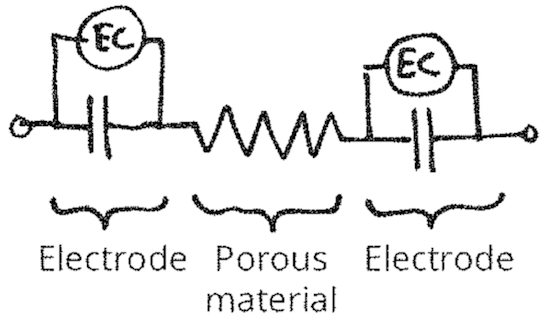
Alar Ainla, Gavin D. M. Jeffries, Owe Orwar & Aldo Jesorka. Granted US Patent number: 9,658,240. Issued: May 23rd 2017.
LINK TO ARTICLE
Aspects of the present invention provide a freestanding microfluidic pipette with integrated wells for solution storage. Further aspects of the invention provide a holding interface to provide connectivity with external control components. One aspect of the invention provides a system for applying a microfluidic device in microscopy. The system includes: a microfluidic device having an elongated shape and defining one or more wells for solution storage and processing; and an interface adapted and configured to hold the microfluidic device in a freestanding manner and facilitate simultaneous connection of the one or more wells with a flow controller. Another aspect of the invention provides a method for utilizing a microfluidic device. The method includes: providing a device as described herein; positioning the device adjacent to a microscope; and actuating the interface to operate the microfluidic device.
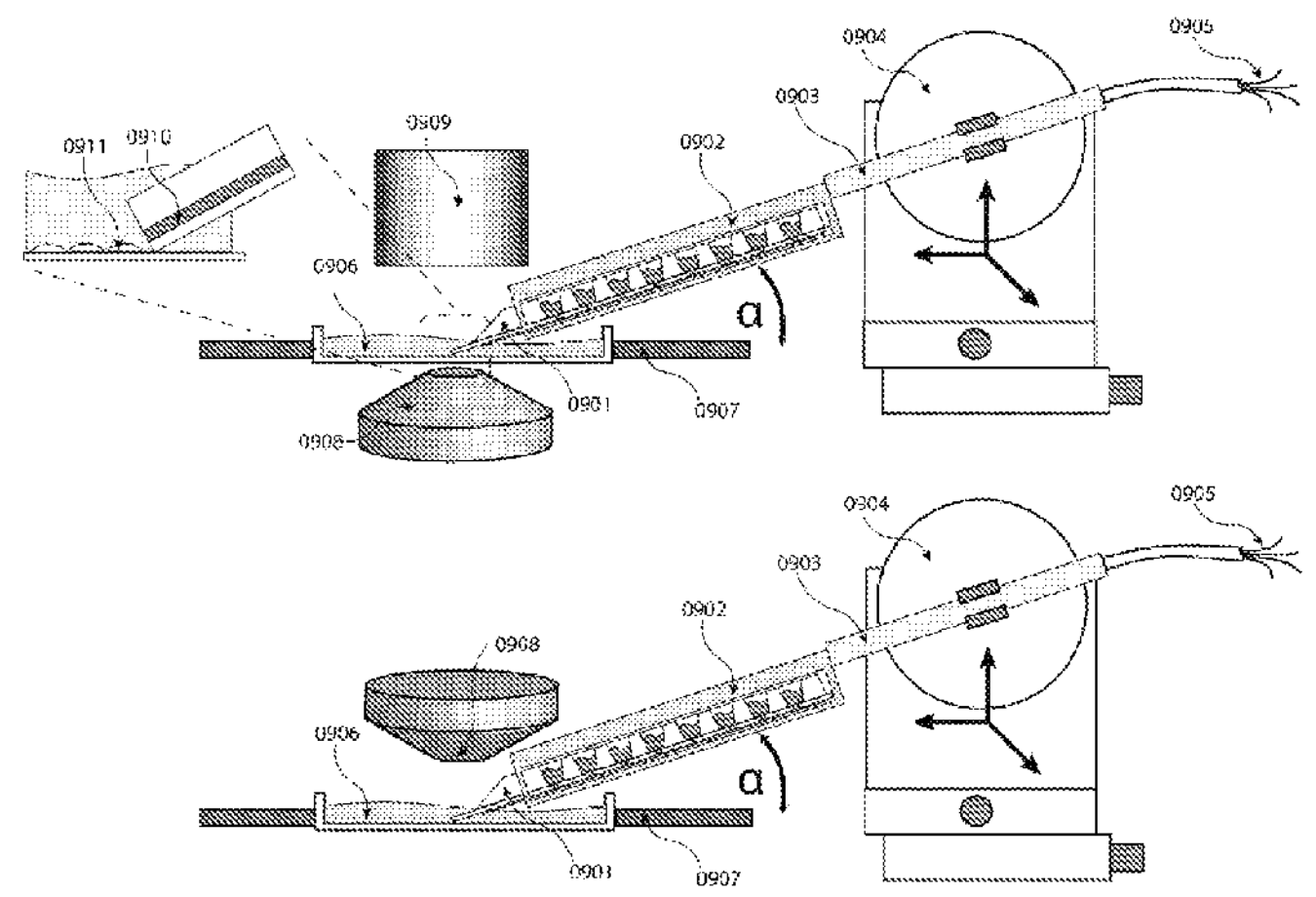
Alar Ainla, Owe Orwar & Aldo Jesorka. Granted US Patent number: 9,671,366. Issued: June 6th 2017.
LINK TO ARTICLE
One embodiment of the invention provides a system adapted and configured to generate a localized flow circulation zone. The system includes: a free-standing microfluidic pipette comprising three or more channels with exits separated from each other by an outer surface of the pipette; and a controller programmed to control fluid flows through each of the three or more channels to generate a localized recirculating fluid flow path outside the pipette. Liquid leaving the microfluidic pipette through at least one outlet channel exit is withdrawn through at least two inlet channel exits.
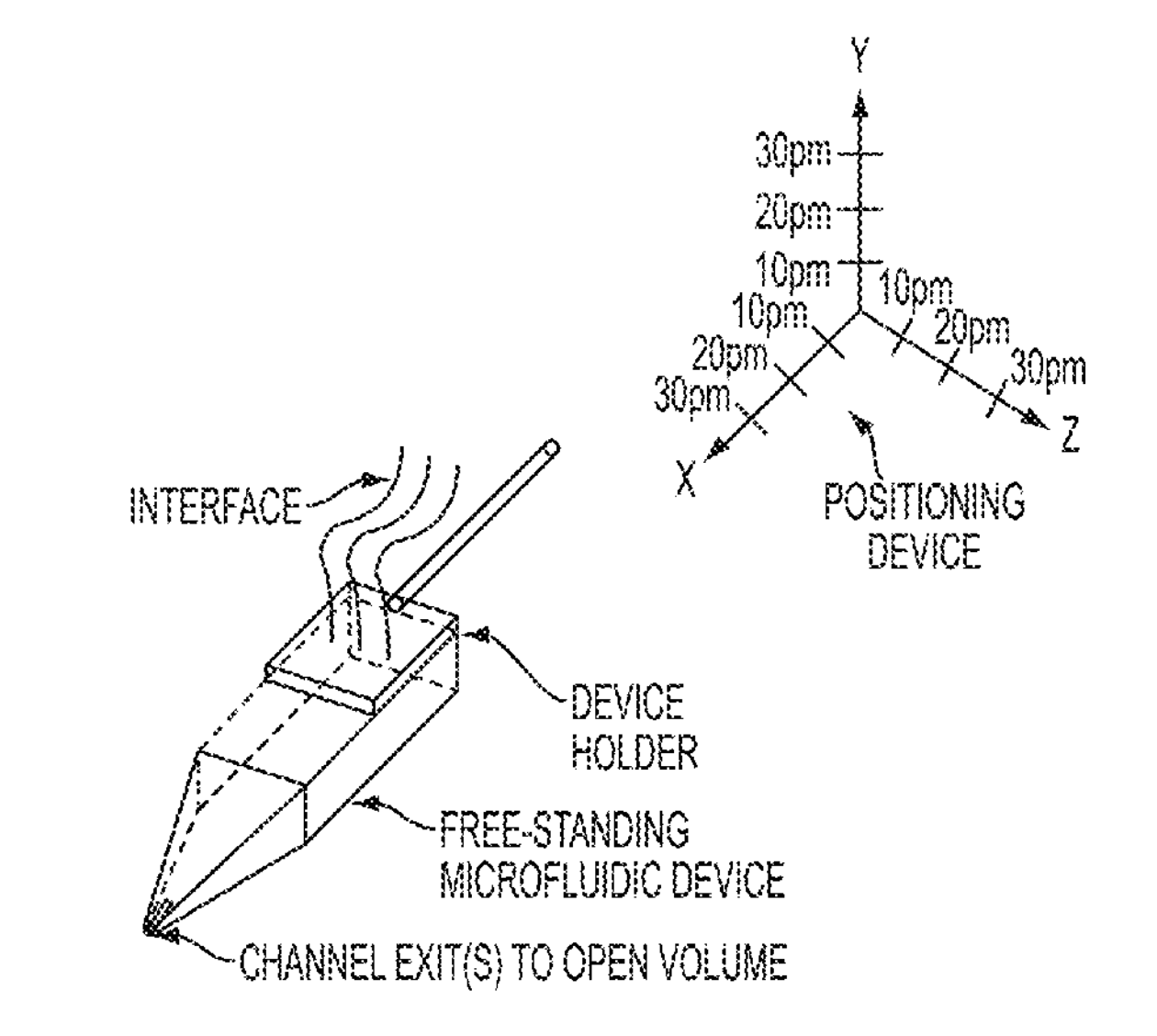
Alar Ainla, Owe Orwar & Aldo Jesorka. Granted US Patent number: 9,126,197. Issued: September 8th 2015.
LINK TO ARTICLE
The present invention features a freestanding microfluidic pipette with both solution exchange capability and fluid re-circulation, enabling highly localized and contamination- free fluid delivery within a confined volume in the vicinity of the pipette exit. Preferably, the device features direct positioning, so the pipette can be directed at a point or object of interest, such as a biological or artificial cell, a defined surface area or a sensor element within an open volume, using micro- or nanopositioning techniques. One aspect of the invention provides a free-standing pipette. The free-standing pipette includes a microfluidic device comprising one or more channels with exits leading into an open-volume and a positioning device programmed to hold the microfluidic device at an angle from a horizontal axis.
Patent Applications
Owe Orwar, Alar Ainla, Gavin David Michael Jeffries, Shijun Xu, US Patent Application 16774453
LINK TO ARTICLE
One aspect of the invention provides a system for dispensing and printing cells and particles. The system includes: (a) a flow confinement device; (b) a controller configured to generate a confined liquid volume outside the flow confinement device, wherein the confined liquid volume or materials contained in the confined liquid volume can be released to the environment by confined, modulated, and non-confined flow modes in arbitrary sequence and for arbitrary periods of time by said controller; (c) one or more liquids containing cells or cell constituents supplied into the confined liquid volume through the flow confinement device; (d) a substrate; and (e) a system configured to position the flow confinement device in 3D space and, therefore, the confined liquid volume to be positioned relative to the substrate, such that the confined liquid volume and contents, can interact with the substrate.
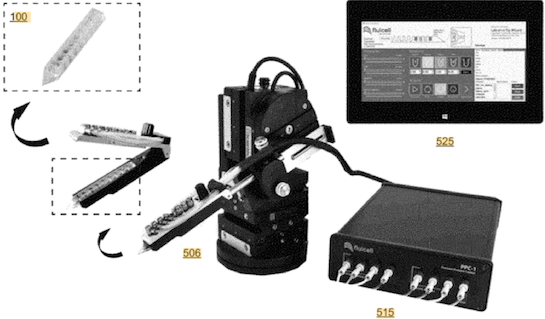
Ana C Glavan, Alar Ainla, Mahiar Max Hamedi, Maria Teresa Fernandez-Abedul & George M. Whitesides Patent Application PCT/US2016/050418. Priority: September 6th, 2015.
LINK TO ARTICLE
An electroanalytical device includes a pin set comprising at least two conductive pins for use as working and counter electrodes, wherein the first and second pins are comprised of a head, a shaft and a piercing tip; and a hydrophobic or omniphobic paper substrate, wherein the substrate is shaped to provide at least one recess for holding a liquid, wherein the shafts of two conductive pins traverse the paper substrate to anchor the heads of the two conductive pins on the recess surface. An electroanalytical device can also include at least two conductive pins for use as working and counter electrodes, a thread, serially wound around the shafts of each of the two conductive pins; and a base into which the piercing tip of each of the pins is secured.
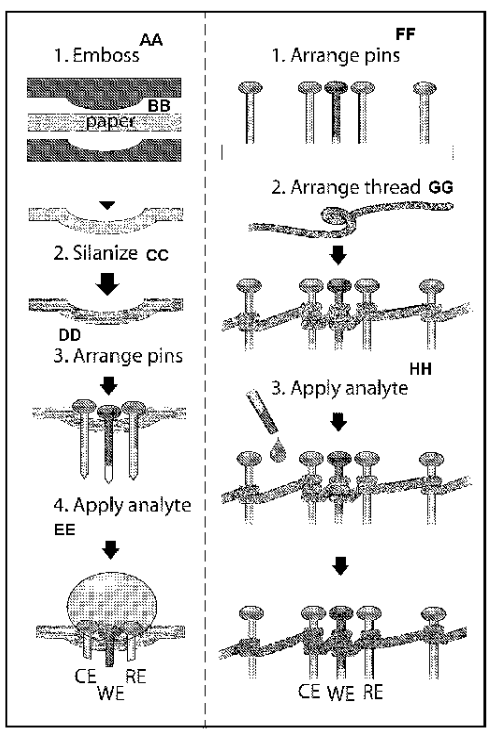
Mahiar Max Hamedi, Philipp Rothemund, Victoria Campbell, Firat Guder, Dionysios Christodouleas, Jean-Francis Bloch, Alar Ainla, Maria Teresa Fernandez-Abedul & George M. Whitesides Patent Application PCT/US2016/050133. Priority: September 2nd, 2015.
LINK TO ARTICLE
In an aspect, a device includes a substrate including a cellulose matrix that provides an interconnected porous structure, a hydrophobic barrier disposed through the thickness of the substrate to define at least one porous channel within the volume of the cellulose matrix, and an electrically conducting material. The electrically conducting material is disposed within the volume of the porous channel to coat at least a portion of the cellulose matrix therein. A method of making and using actuators, electrochemical sensors, and batteries based on the device are also disclosed.
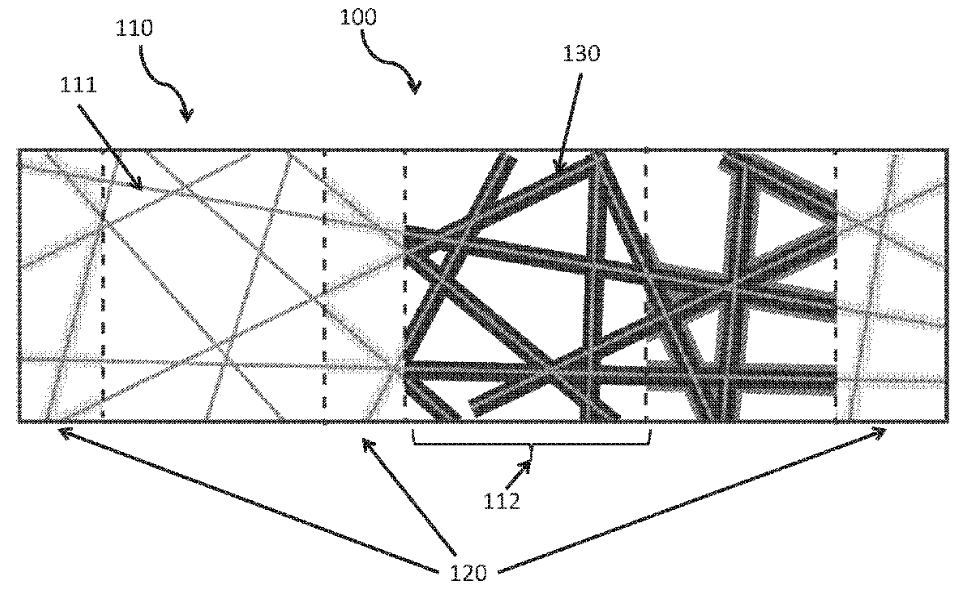
Alar Ainla, Mahiar Max Hamedi, Firat Guder & George M. Whitesides. Patent Application PCT/US2016/018336. Priority: February 17th, 2015.
LINK TO ARTICLE
A fluid gating valve includes a porous hydrophobic layer which acts a barrier for liquid flow; a liquid source on one side of the porous layer; a liquid drain on the opposing side of the porous hydrophobic layer; a source electrode in electrical connection with the liquid source; and a gate electrode electrically insulated from the liquid source, wherein the source electrode and the gate electrode are positioned and arranged to be connectable to a voltage source. And valve can be open by applying voltage between the gate and the source electrodes.
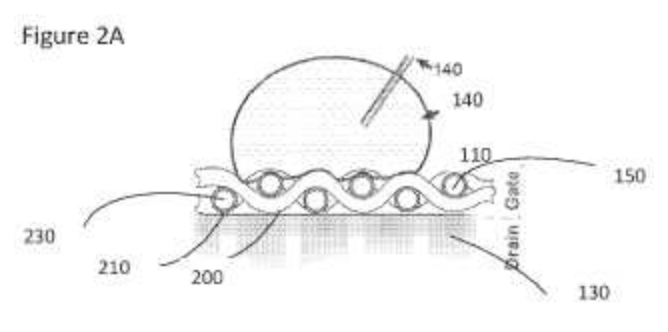
Firat Guder, Bobak Mosadegh, Alar Ainla & George M. Whitesides Patent Application PCT/US2015/056971. Priority: October 22nd, 2014.
LINK TO ARTICLE
A method of and system for detecting a gas or vapor includes providing a sensor comprising an electrode pair in electrical contact with a layer of porous material, the porous material layer having water adsorbed on its surface; contacting the sensor with a gas or vapor sample to be analysed; applying a voltage across the electrode pair of the sensor; and measuring a response, the response correlating to the presence of a target gas or vapor.
Alar Ainla, Irep Gozen, Aldo Jesorka & Mehrnaz Shaali. Patent Application PCT/US14/12157. Priority: January 19th , 2013.
LINK TO ARTICLE
One aspect of the invention provides a method for fabrication of a membrane on a surface. The method includes: providing a surface interfacing two environments, wherein one of the environments is a liquid; providing a flow-recirculating fluidic device having channel exits in the liquid environment in proximity of the surface; and delivering locally one or more processing solutions. The one or more processing sources including one or more membrane sources adapated and configured to form a membrane on the surface.
Alar Ainla, Gavin D. M. Jeffries, Owe Orwar & Aldo Jesorka. Patent Application PCT/US12/36758. Priority: May 6th, 2011.
LINK TO ARTICLE
Aspects of the present invention provide a freestanding microfluidic pipette with integrated wells for solution storage. Further aspects of the invention provide a holding interface to provide connectivity with external control components. One aspect of the invention provides a system for applying a microfluidic device in microscopy. The system includes: a microfluidic device having an elongated shape and defining one or more wells for solution storage and processing; and an interface adapted and configured to hold the microfluidic device in a freestanding manner and facilitate simultaneous connection of the one or more wells with a flow controller. Another aspect of the invention provides a method for utilizing a microfluidic device. The method includes: providing a device as described herein; positioning the device adjacent to a microscope; and actuating the interface to operate the microfluidic device.
Alar Ainla, Owe Orwar & Aldo Jesorka. Patent Application PCT/IB2010/003307. Priority: Dec 3rd 2009.
LINK TO ARTICLE
The present invention features a freestanding microfluidic pipette with both solution exchange capability and fluid re-circulation, enabling highly localized and contamination- free fluid delivery within a confined volume in the vicinity of the pipette exit. Preferably, the device features direct positioning, so the pipette can be directed at a point or object of interest, such as a biological or artificial cell, a defined surface area or a sensor element within an open volume, using micro- or nanopositioning techniques. One aspect of the invention provides a free-standing pipette. The free-standing pipette includes a microfluidic device comprising one or more channels with exits leading into an open-volume and a positioning device programmed to hold the microfluidic device at an angle from a horizontal axis.